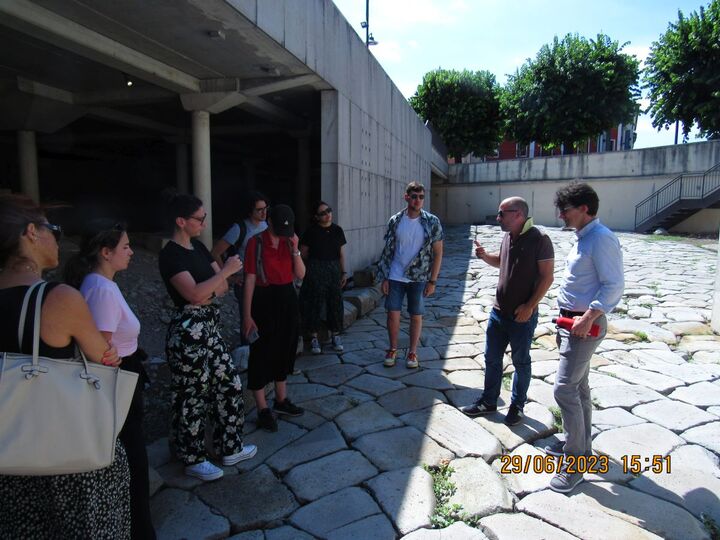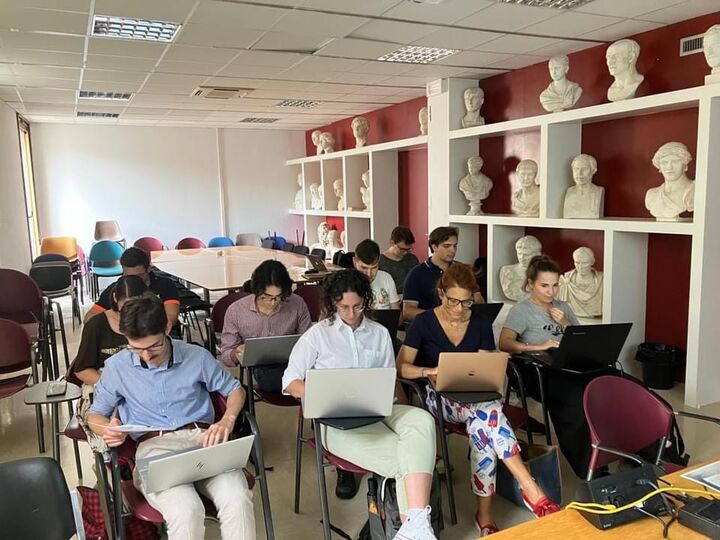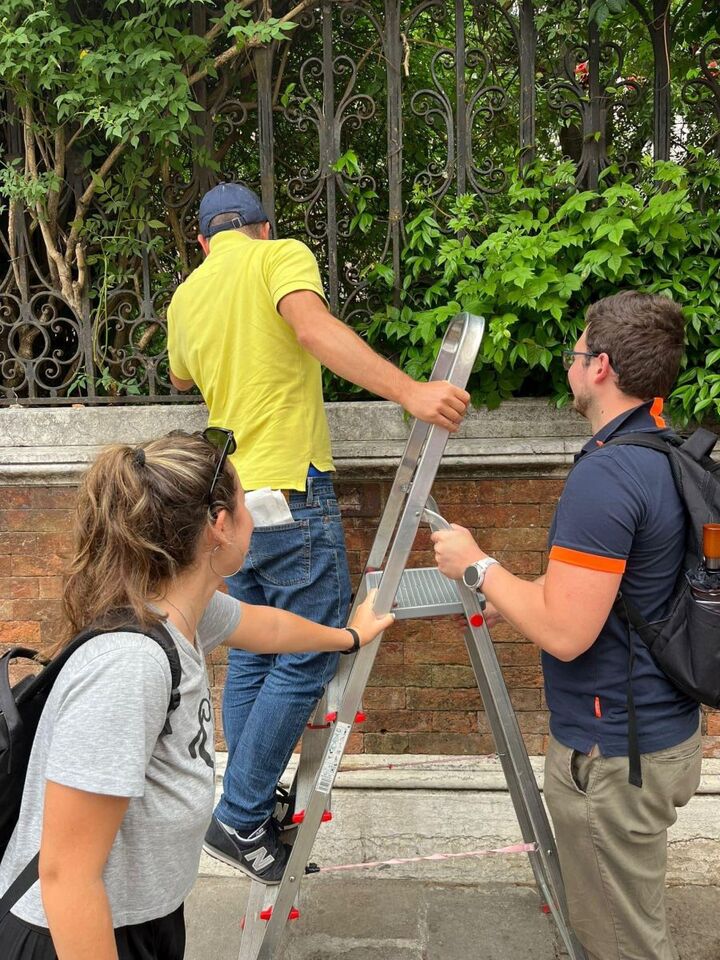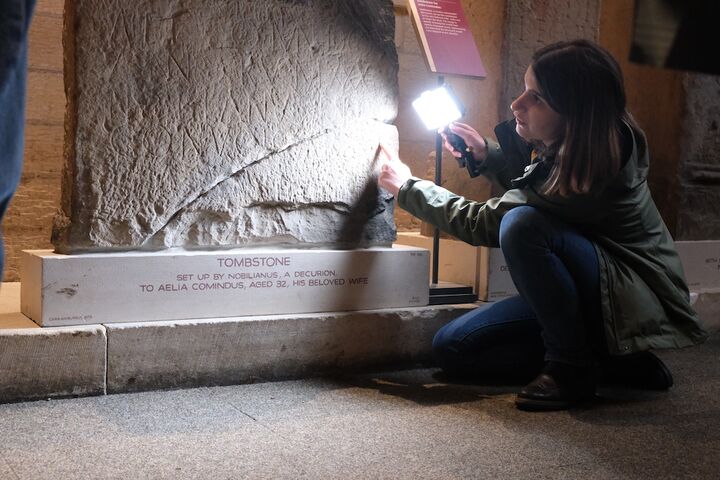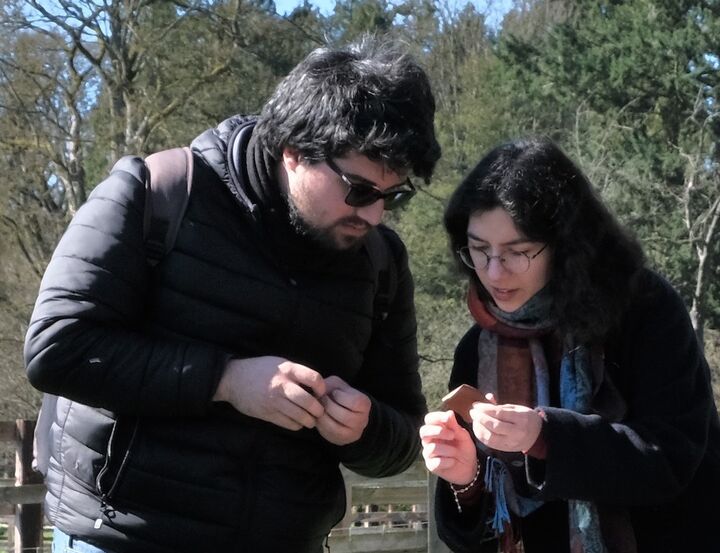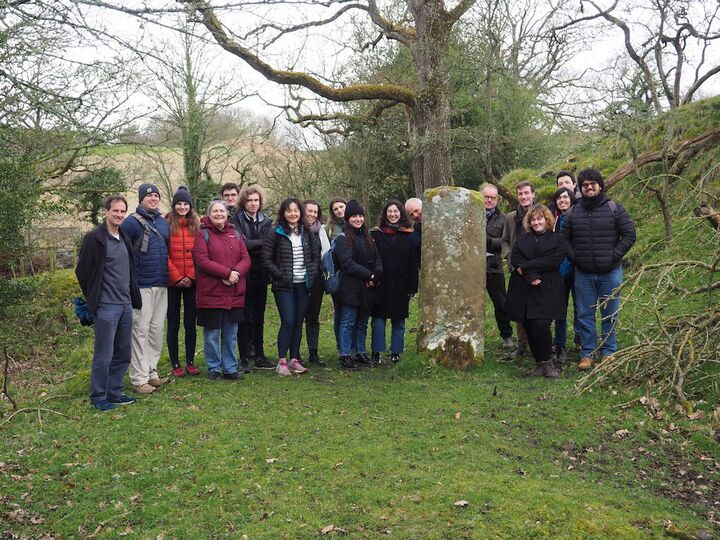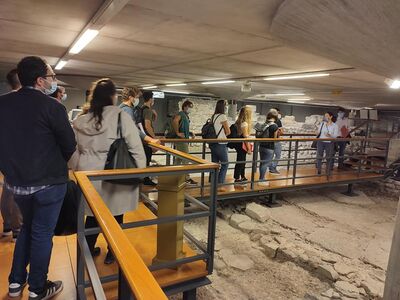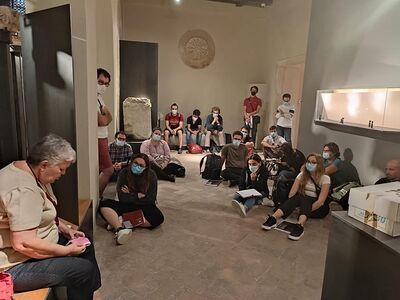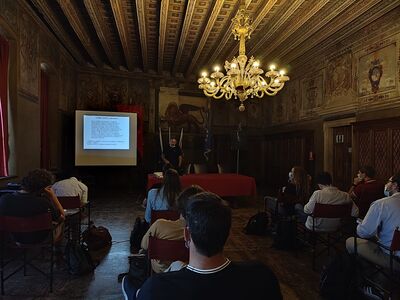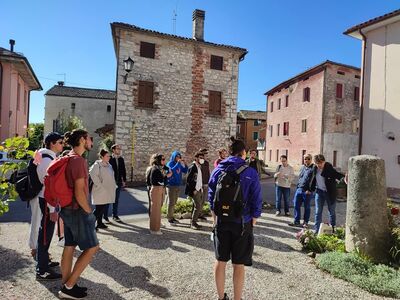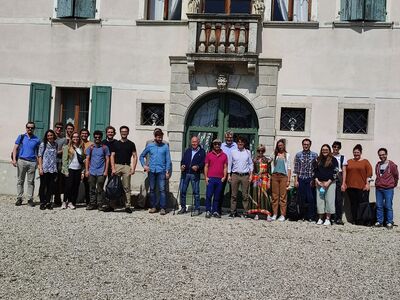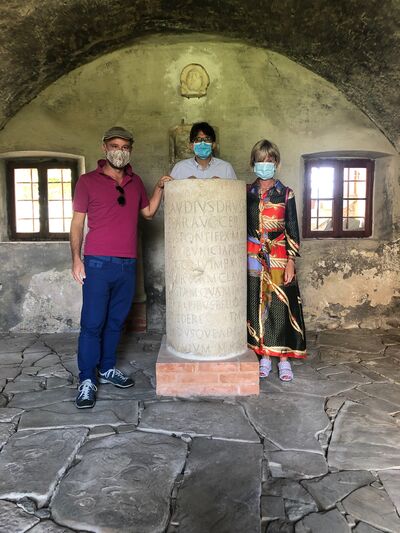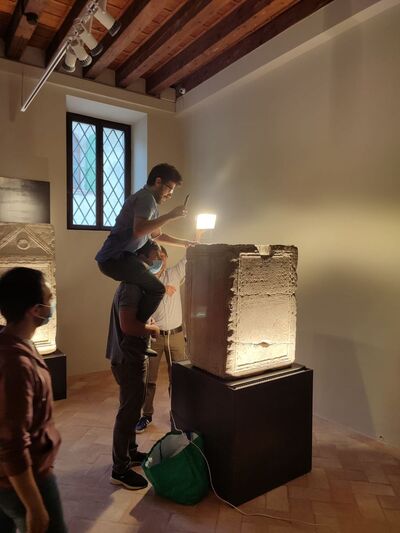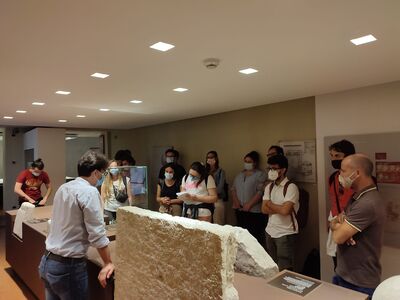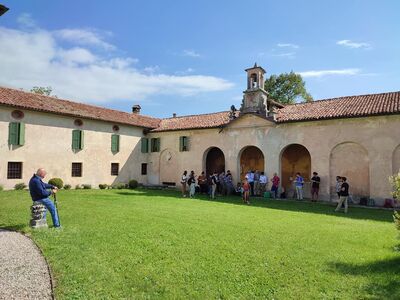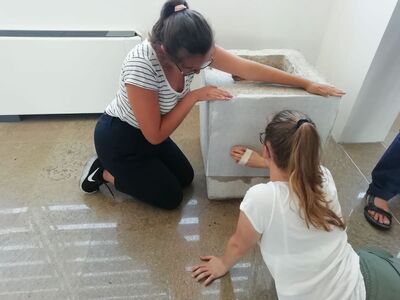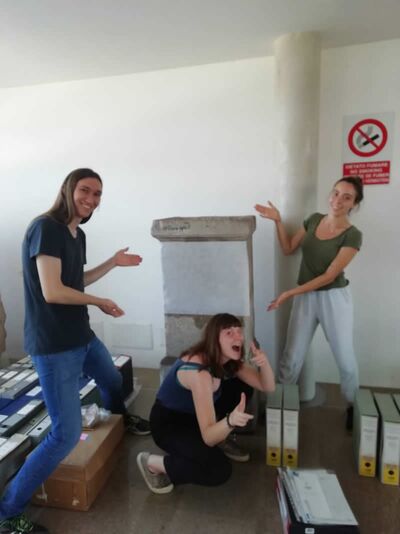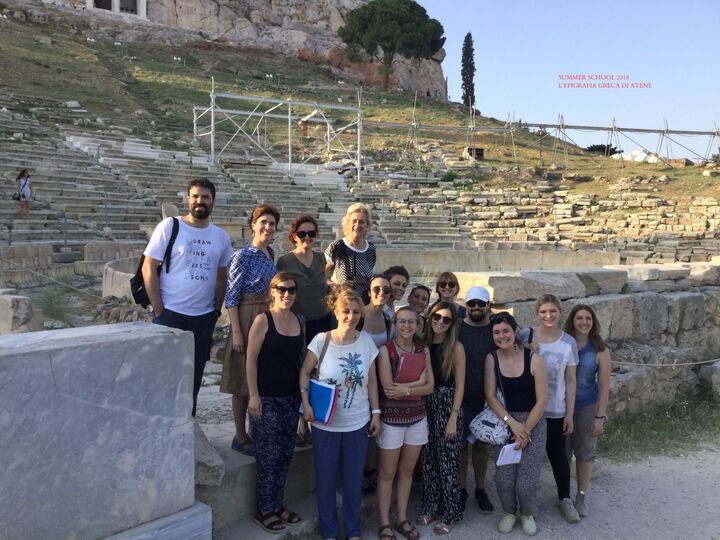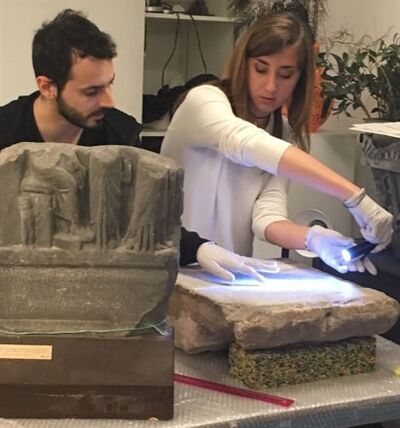Winners 2023
Giovannella Cresci und Lorenzo Calvelli – Report 2023
La XXII edizione dello Stage epigrafico ad Altino e dintorni si è svolta da lunedì 26 a venerdì 30 giugno 2023 grazie anche al sostegno dell'Association Internationale d'Épigraphie Grecque et Latine (AIEGL).
Allo Stage hanno partecipato 11 studenti, iscritti ai corsi di laurea triennale e magistrale:
- Riccardo Arrighi
- Giovanni Bassetto
- Leonardo Battistella
- Serena Chiarel
- Mattia Dall'Asta
- Giacomo Furlan
- Mariana Moya Gómez
- Silvia Parcianello
- Marta Polverino
- Roberto Russo
- Susanna Spolaore
Si sono alternati all'insegnamento, secondo le rispettive specificità disciplinari, 7 docenti:
- Lorenzo Calvelli
- Giovannella Cresci
- Marcella De Paoli
- Giovanna Gambacurta
- Franco Luciani
- Anna Marinetti
- Sabrina Pesce
Sabrina Pesce ha svolto anche il ruolo di tutor degli studenti partecipanti. Non è mancato il contributo dei direttori dei musei visitati, che hanno provveduto a introdurre le visite alle collezioni epigrafiche con l'illustrazione della storia dei singoli presidi espositivi.
Lo Stage ha inteso trasmettere ai frequentanti le seguenti competenze, difficilmente sviluppabili all'interno di un normale corso basato sulla didattica frontale:
- metodologia della ricognizione autoptica dei documenti epigrafici su pietra, metallo, ceramica e vetro;
- esperienza di epigrafia applicata con simulazione di incisione di iscrizioni su pietra e piombo;
- capacità di ripercorrere e decifrare la tradizione manoscritta dei documenti epigrafici;
- comprensione dei fenomeni del reimpiego architettonico delle iscrizioni e del collezionismo epigrafico;
- tecniche di riproduzione fotografica digitale dei reperti iscritti, con particolare riferimento a quelli di piccole dimensioni e di problematica decodificazione;
- confezione di facsimili ricostruttivi e calchi su carta;
- schedatura delle iscrizioni all'interno del database informatico EDR (Epigraphic Database Roma), federato nel progetto EAGLE (Europeana network of Ancient Greek and Latin Epigraphy);
- capacità di ricerca negli inventari di collezioni pubbliche e private;
- sviluppo di abilità nel campo della didattica museale e della comunicazione dei risultati della ricerca.
Si è trattato di un'esperienza didattica innovativa perché:
- ha coinvolto gli studenti in un contatto diretto con i monumenti iscritti, trasferendo la loro esperienza formativa dal livello teorico a quello pratico;
- ha consentito di acquisire competenze plurime (esegetiche, informatiche, paleografiche, glottologico/linguistiche, museali, comunicative);
- ha fornito una chiave di lettura interdisciplinare per lo studio degli oggetti portatori di scrittura, introducendo gli studenti non solo all'epigrafia latina, ma anche alla comprensione delle culture epigrafiche della Venetia preromana, con particolare attenzione per le iscrizioni venetiche;
- ha messo a contatto con differenti ambienti lavorativi (musei archeologici, biblioteche, archivi) e con operatori afferenti ad istituzioni di natura eterogenea e portatori di molteplici professionalità;
- ha permesso di frequentare le diverse articolazioni delle istituzioni museali (non solo le sale espositive, ma anche i magazzini, le realtà inventariali, i gabinetti fotografici, i centri di restauro), consentendo di acquisire un'esperienza diretta delle realtà di lavoro connesse con la scoperta, lo studio, l'edizione scientifica, la disseminazione, l'informatizzazione e la musealizzazione dei documenti antichi.
Il Grant for Epigraphic Educational and Training Courses and Workshops generosamente fornito dall'AIEGL è servito a coprire tutte le spese di mobilità degli studenti e una parte delle spese organizzative dello Stage.
In fede,
Lorenzo Calvelli
Giovannella Cresci
Peter Haarer (Oxford) – Report 2023
Practical Epigraphy Workshop 2023, Chesters Corbridge, Northumberland, 25–29 March 2023
Thanks to the generous support of sponsors including l' Association Internationale d’Épigraphie Grecque et Latine we were again able to run the Practical Epigraphy Workshop this year and to provide epigraphic training to a further eighteen students (bringing the total number of participants who have completed the course so far to 183 over the twelve iterations since 2007). We received 31 applications for the places available, including 22 from British and European nationals and nine from the rest of the world (Turkish, US, Canadian, Australian, and Chinese). A list of participants is provided below.
This year's programme repeated the successful format from 2022 which involves groups working at Chesters and Corbridge simultaneously and studying the exquisite inscriptions in each collection while both sites are closed to the general public. We could not have achieved this feat without the indispensable as well as most generous help from Frances McIntosh, or that of the Trustees of the Clayton Collection. A significant change to this year's timetable was to arrive one day earlier and to leave one day later to allow for more time for study of the stones and time in which to do justice to the archaeological context of Hadrian's Wall. Sites visited included Roman Chesters, Corbridge Roman Town, Carrawburgh (with the adjoining Mithraeum and Coventina's Well), Limestone Corner, and Vindolanda. We also moved the practical sessions on photography and on squeeze-making to a conference facility at our hotel accommodation (for squeeze-making we now use ancient stones rarely and instead bring our own modern material kindly donated for the purpose).
I am eternally grateful to the Workshop team for dealing patiently with the demands of the course and various unexpected challenges, whether the creation of an ad hoc lecture theatre, or working around the breakdown of the hired minibus and consequential loss of our main transport for most of one day. The prize of "Star Epigrapher", as ever, goes without question to Roger Tomlin for his indefatigable enthusiasm and openness to sharing his unrivalled expertise and knowledge on the inscriptions of Roman Britain, whether giving advice on particular pieces within the museums, or giving introductions to writing tablets from Carlisle or graffiti on Samian ware: what would we do without him?
Peter Haarer (Course Director)
This year's sponsors: Centre for the Study of Ancient Documents (University of Oxford), University of Lincoln, Craven Committee, British Epigraphy Society, Association Internationale d’Épigraphie Grecque et Latine, Society for the Promotion of Hellenic Studies, Society for the Promotion of Roman Studies, Jowett Copyright Trustees, Trustees of the Clayton Collection, Haverfield Fund.
This year's team: Peter Haarer (Oxford); Roger Tomlin (Oxford), Charles Crowther (Oxford), Olivia Elder (Oxford), Henning Schulze (University of Lincoln). Administrative support: Chloe Colchester (CSAD, Oxford).
Peter Haarer (Oxford) – Report 2021
Practical Epigraphy Workshop, Corbridge & Chesters, Northumberland, 27–28 March 2022
After a long break due to the pandemic, it was a pleasure to travel to Northumberland for the eleventh iteration of the Practical Epigraphy Workshop at the Roman sites of Corbridge and Chesters. The main group of participants was divided into two for most of the duration and so, rather than being one workshop, it was really two workshops running in parallel. The resulting organisational and logistical challenges were considerable but the rewards were immense as we could offer a vast array of material for study, as well as accommodating twice the number of participants than had we used a single site. Contextualisation through exploration of the Roman remains in the environs formed an integral part of the course, including visits to Roman Brocolitia with its Mithraeum and the well of Coventina, and the remains of quarrying at Limestone Corner. We also visited Vindolanda on our way home (in an evocative flurry of snow).
The Workshop attracted eighteen high-calibre students at various stages of their careers, ranging from undergraduates to post–docs, and representing countries from across the globe (twelve from Britain & Europe, and a further six from the US, Australia, Hong Kong, and China). For most, this was their first ever visit to Hadrian's Wall and there was an audible gasp of delight on entering the exhibition at Corbridge and on seeing the Clayton Collection at Chesters. The immense satisfaction in dealing with real inscribed material in the field rather than publications in libraries was also very evident.
No event of this kind can succeed without a strong and reliable team. This included Roger Tomlin (Oxford), Charles Crowther (Oxford), Henning Schulze (Lincoln), and Olivia Elder (Oxford) who kindly stepped in at short notice to act as a very capable assistant director. Behind the scenes, Frances McIntosh and team at Corbridge and Chesters made sure that we had access to all of the material and facilities that we needed, while Chloe Colchester at the Centre for the Study of Ancient Documents in Oxford provided vital administrative support.
We must also thank our generous sponsors: the Centre for the Study of Ancient Documents, Oxford, the Craven Committee, Oxford, the Trustees of the Clayton Roman Trust and, of course, the Association Internationale d’Épigraphie Grecque et Latine (AEIGL).

Winners 2019
Giovannella Cresci und Lorenzo Calvelli – Report 2019
Winners 2018
Enrica Culasso Gastaldi – Report
La Summer School dedicata all'Epigrafia Greca di Atene si è svolta ad Atene dal 4 al 12 giugno 2018 e si è realizzata grazie alla Convenzione tra il Dipartimento di Studi Storici dell'Università di Torino, la Scuola Archeologica Italiana di Atene e il Museo Epigrafico di Atene.
Hanno partecipato tredici studenti e dottorandi provenienti dalle Università di Bari, Napoli, Palermo, Roma, Torino, Vercelli. La vincitrice della borsa di studio AIEGL del valore di 500 euro è stata la dott. ssa Lara Varotto, Dottoranda presso l'Università degli Studi di Roma Tre. Il Comitato Organizzatore della Summer School ha messo inoltre a disposizione altre due borse di studio del valore di 500 euro ciascuna.
Le lezioni in aula si sono svolte presso la SAIA e le esercitazioni pratiche presso il Museo Epigrafico, il Museo dell'Acropoli, l'area archeologica del Ceramico, dell'Agora e delle pendici sud dell'Acropoli. Il programma didattico è stato completato, sotto un profilo storico, attraverso una visita didattica al Pireo e alla Pnice. Si sono forniti informazioni sulle sitografie epigrafiche e sulle nuove tecnologie applicate all’epigrafia.
Il programma specifico ha contemplato esercitazioni sulle epigrafi funerarie e votive, sui decreti, sulle dediche, sui documenti di rendicontazione, sulle iscrizioni coregiche. I documenti esaminati nel contesto museale sono stati poi riportati al proprio ambito topografico di pertinenza attraverso la visita al sito archeologico corrispondente. Ogni partecipante ha praticato una propria esperienza autoptica con preparazione di una scheda epigrafica elaborata secondo i criteri accreditati in sede scientifica. Nella preparazione dei partecipanti si è costantemente seguito una metodologia che avviasse innanzitutto alla comprensione tecnica del documento esaminato e successivamente anche a una valutazione storica della testimonianza epigrafica.
I docenti che si sono susseguiti nella preparazione dei partecipanti alla Summer School sono stati: Enrica Culasso Gastaldi, Carmelo Di Nicuolo, Chiara Lasagni, Andronike Makres, Daniela Marchiandi, Angelos Matthaiou, Athanasios Themos.
L'esercitazione sui calchi è stata curata dal Conservatore del Museo Epigrafico sig. Theodoros Mavridis.
Enrica Culasso Gastaldi
Università degli Studi di Torino
Winners 2018
Abigail Graham (Warwick) and Peter Haarer (Oxford) – Report
Practical Epigraphy Workshop 2018 Ashmolean Museum, Oxford, June 25th-27th
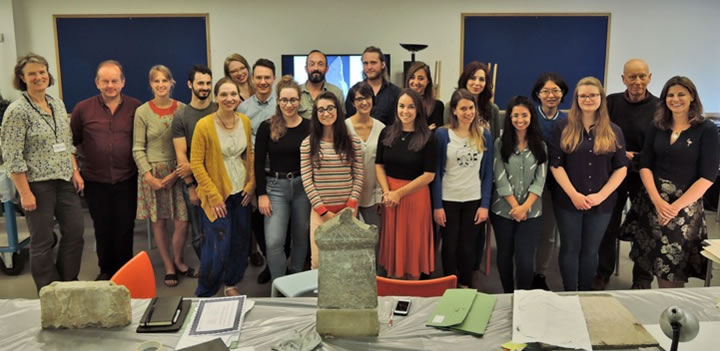
A three-day Practical Epigraphy Workshop took place in Oxford from June 25th-27th in collaboration with the Centre for Study of Ancient Documents and the Ashmolean Museum.
The aim of the course was to offer expert guidance and a “hands on” practical experience with inscriptions: how they are created, studied, recorded and presented both in the field and in museums. The program included numerous interactive experiences with inscriptions: drawing and measuring the stones, imaging, making squeezes; together with aspects of further study, such as the production of transcriptions, translations and commentaries.
The Ashmolean’s facilities and expert staff, including museum curator Dr. Anja Ulbirch, allowed students to study stones that were otherwise inaccessible to the public, as well as few inscriptions which were on display, providing a rare opportunity to study a single inscription in a variety of different media. Material for the workshop including squeezes and materials for making squeezes, drawings, transcriptions, and commentaries were generously provided by the Centre for Study of Ancient Documents. Instructors, Roger Tomlin (Oxford), Abigail Graham (Warwick), Charles Crowther (Oxford), and Peter Haarer (Oxford) presented a range of interests and approaches across a broad chronological and geographical scopes.

New elements of this course included a lecture on “Latin Cursive on Samian Wares” by Roger Tomlin and a carving demonstration given by one of the participants, a professional letter cutter: Wayne Hart. Wayne provided drawings and a beautiful illustration of how the carving process took place: selecting the stone, choosing the space, making measurement and drawings, and carving the stone. Participants had the opportunity to experience the act of carving, both by observing Wayne and then picking up a chisel themselves. This was a truly transformative, enlightening and enjoyable event.
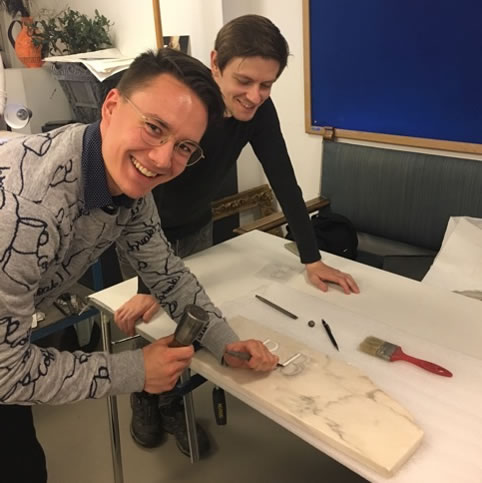
The 18 course participants were a group of wonderfully diverse individuals from 14 universities, 7 countries and 3 continents, ranging from final year undergraduates to late stage Ph.D candidates. Based on their course applications, participants were paired with materials and scholars related to their fields of study, and assigned a specific inscription, which they examined in “hands-on” basis throughout the course. Evening dinners with course instructors in the University’s colleges (Trinity and Corpus Christi) were also an excellent opportunity for developing ideas and collegial bonds that last well beyond the course. All participants presented their assigned inscriptions on the final day of the course.
The course ended with a special curator’s tour of the Ashmolean, given by Anja Ulbrich, who took students through the process of presenting and collecting museum materials. The collaborative efforts of the Ashmolean museum and the Centre for Study of Ancient Documents resulted in an unparalleled interactive learning experience, that few universities or museums are able to offer. Our ability to offer this course at such an accessible cost (£130), appealed to many international applicants, was dependent upon the support of a generous AIEGL grant.

